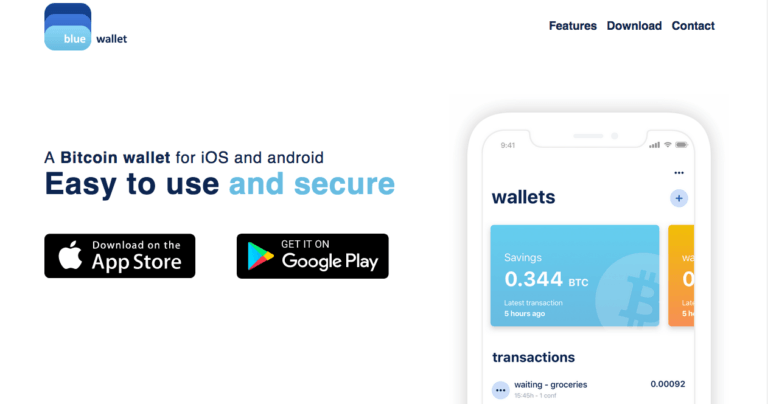The recently released versions of mobile Bitcoin (BTC) wallet app BlueWallet bring support for the Lightning Network to iOS and Android users who do not know (or want to know) anything about running a Lightning node (e.g. having to open state channels or maintaining liquidity in channels).
Background
BlueWallet is an open source (MIT-licensed) mobile Bitcoin wallet that was created as the result of a collaboration between UX Designer and Product manager Nuno Coelho (based in Barcelona) and developers Igor Korsakov (based in London) and Marcos Rodriguez (based in Atlanta).
In a blog post published on December 3rd, Coelho explained the motivation behind BlueWallet:
“We were deeply frustrated with the current status of mobile wallet development on Bitcoin. Most of the wallets out there became a shitcoin horror show. Onboarding users to pure speculative useless tokens, where the creators are making money while the normal user is being introduced to scams, frauds on top of being directed to the least interesting aspect of the technology. Wasting time, creating frustration, and thereby resulting to a slow adoption… We want to bring to the community a wallet focused on the users and their usage.”
He also explained that the BlueWallet team would be focusing its efforts on two pillars: “Security and User Experience.”
BlueWallet’s features include
- Sentinel Wallets: “Watch-only wallets allow you to keep an eye on your cold storage without touching your private key. Easily import your address or xpub and watch it from your app without ever touching it.”
- SegWit: “SegWit supported in P2SH-compatibility mode.”
- HD Wallets: Support for “Hierarchical Deterministic (HD) key creation and transfer protocol (BIP32)” means that a public key is generated for each transaction.
- Multiple Wallets: All major wallet standards, i.e. BIP44 (HD), BIP49 (HD SegWit), BIP39 (Breadwallet-compatible), Legacy single-address, and SegWit single-address (P2SH) are supported.
- Flexible Fees: Starting with 1 Satoshi, you control “the amount you want to add to your transaction,” with BlueWallet assisting providing “fee estimation to give you an idea how much to add to your transaction to be included on the next block.”
- Lightning Wallets: Support for the Lightning protocol means you have access to ultra cheap and fast transactions.
Support for the Lightning Network
In a blog post published on Wednesday (December 19th), BlueWallet’s lead developer Igor Korsakov announced that BlueWallet had just added support for the Lightning Network. Korsakov started by saying that although the Lightning Network “promises low-fees and instant payments,” it has the drawback of bringing “a lot of complexities and unfamiliarities to unsuspecting users.”
He then said that they had decided to take a new approach to Lightning:
“We decided to hide the complexity of running a node under the hood and take over the work of hub operator. This makes the user experience smooth, bringing Lightning payments to anyone who is at least remotely acquainted with cryptocurrencies and mobile wallets. We called it LndHub, an opensource wrapper around LND. This is '3rd layer solution' (as we jokingly call it; of course this is not real 3rd layer).”
And this is how Korsakov explained how this approach works:

“… the user sends his bitcoins to a dedicated top-up address, and this balance is added to his account on LndHub. Then, the user can use this balance to pay Lightning invoices. But under the hood, it’s actually LndHub who pays the invoice, deducting the user’s account balance. It works the same way when the user wants to receive a Lightning payment — it’s LndHub who creates Lightning invoice and actually receives coins on one of its channels.”
Finally, Korsakov moved on to a discussion of the pros and cons of their approach.
Pros:
- “Improves user experience, allowing to onboard more users”
- “Completely removes technicalities, like opening and maintaining channels and liquidity (both incoming and outgoing)”
- “Improves chances of successful payment routing”
- “Receiving payments is a breeze (lndhub and lnd are 100% online, no need for Watchtowers)”
- “Single LndHub (if self-hosted) can help share lightning experience with many users (think friends and family)”
Cons:
- “Funds are held by a 3rd party (but only small amounts for everyday use). Mitigated by opensourcing LndHub”
- “Minor network centralization”
- “Less private. Hub operator knows who paid whom. Luckily, trust is minimized as Hub doesn’t know who is on sending and who is on receiving end, and what is being paid for. And again, LndHub is opensource for people needing extra privacy.”
Upcoming Features
Here are three features that will be coming in the near future:
- Batch TX: “Ability to pay multiple addresses with a single transaction. Save on fees and optimize blockspace usage.”
- MultiSig TX: “Add security to your funds. Each transaction requires M of N signatures (with keys stored on different physical devices with Blue Wallet).”
- Plug Your Own Node: “Plug your own Bitcoin Core node for a maximum sovereignty.”
All Images Courtesy of BlueWallet Services S.R.L.









